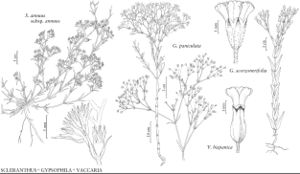Gypsophila
Sp. Pl. 1: 406. 1753.
Gen. Pl. ed. 5, 191. 1754.
| Taxon | Illustrator ⠉ | |
|---|---|---|
 | Scleranthus annuus subsp. annuus Gypsophila paniculata Gypsophila scorzonerifolia Vaccaria hispanica | Barbara Alongi Barbara Alongi Barbara Alongi Barbara Alongi |
Plants annual or perennial. Taproots slender to stout, sometimes absent; perennials often with stout, branched caudices, some with adventitious-roots from decumbent stems or elongating rhizomes. Stems erect, ± sprawling, or less often decumbent or prostrate, usually branched, terete. Leaves briefly connate proximally, sessile; blade 1-veined or 3–5-veined, linear to oblong or ovate, apex rounded or obtuse to acuminate. Inflorescences dichasial cymes or thyrses, diffuse (to subcapitate in G. oldhamiana); bracts paired, proximal bracts foliaceous, distal ones smaller, herbaceous with scarious margins; involucel bracteoles absent. Pedicels erect in fruit. Flowers: sepals connate proximally into cup, 1–5 mm, cup green-and-white, 5-veined, not winged, obconic to campanulate, terete to 5-angled, commissures between sepals veinless, broad, scarious; lobes green at least along midrib, usually ovate to elliptic, equaling or longer than cup, margins white, scarious, apex rounded to obtuse, sometimes mucronate; petals 5, white, pink, or rose-purple, claw poorly differentiated, auricles absent, coronal appendages absent; blade apex entire or shallowly emarginate to 2-fid, nectaries at filament bases; stamens 10, arising with petals from low nectariferous disc; filaments distinct nearly to base; staminodes absent; ovary 1-locular; styles 2 (–3), clavate, 1.2–2.5 mm, glabrous proximally; stigmas 2 (–3), subterminal, papillate (30×). Capsules globose or ellipsoid-ovoid, opening by 4 (–6) slightly distally recurving valves; carpophore absent. Seeds 4–36, brown to black, reniform to snail-shell-shaped, laterally compressed, tuberculate, marginal wing absent, appendages absent; embryo peripheral, curved. x = 17, 12 (Eurasia), 18 (Eurasia); aneuploidy occasional.
Distribution
Introduced; temperate Eurasia, Africa, Pacific Islands, Australia, in South America
Discussion
Species ca. 150 (4 in the flora).
Gypsophila species are widely grown as ornamentals. In addition to those treated below, other European and Asiatic species have appeared sporadically in disturbed habitats in the flora area, sometimes remote from any site where likely to have been planted, but have not become established. Gypsophila pilosa Hudson [G. porrigens (Linnaeus) Boissier], which differs from G. elegans in its stems villous or hispid proximal to the inflorescence, slender pedicels that persist after the flowers and fruits have fallen, and consistently pink petals, has been found at waste-disposal sites in Maryland, New York, and Oregon. Gypsophila repens Linnaeus, a rhizomatous perennial species with prostrate to decumbent primary stems and more or less erect flowering branches to 3 dm, similar to G. elegans in floral characters, has been found escaped from cultivation in British Columbia and Maine. Gypsophila oldhamiana F. A. W. Miquel was found in a field in Alabama in 1969 [Rebois 049 (AUA)]. It has pink petals and differs from other species described here in its densely corymboid to subcapitate inflorescences. Additional species are cultivated in the flora area.
All reports of Gypsophila acutifolia Steven ex Sprengel, G. perfoliata Linnaeus in the narrow sense, G. stevenii Fischer ex Schrank, G. arrostii Gussone, and G. pacifica Komarov (G. perfoliata var. latifolia Maximowicz) as naturalized species in the flora area appear to have been based on misidentified G. scorzonerifolia. The inflorescences of G. acutifolia are denser than those of G. scorzonerifolia, with the pedicels of the former being less than two times the calyx length, and those of the latter mostly being more than two times as long. True G. perfoliata and G. pacifica, neither of which is known in North America outside of cultivation, differ from G. scorzonerifolia in having glabrous pedicels and calyces; G. perfoliata differs also in having almost completely green sepals with the narrow white margins not sharply defined, and minutely rather than coarsely tuberculate seed coats.
All of the species described below, especially Gypsophila scorzonerifolia, can be expected to be found elsewhere in the flora area.
Selected References
Lower Taxa
Key
| 1 | Plants annual; stems diffusely branched throughout, 0.4-3(-4) dm; leaf blades linear,0.2-2(-3) mm wide; petals usually pink | Gypsophila muralis |
| 1 | Plants annual or perennial; stems simple or few-branched proximal to inflorescence in annuals, or variously branched in perennials, 0.4-20 dm; leaf blades lanceolate to ovate, (1-)2-20(-35) mm wide; petals purplish pink or white | > 2 |
| 2 | Plants annual; petals 6-15 mm | Gypsophila elegans |
| 2 | Plants perennial; petals 1-6 mm | > 3 |
| 3 | Leaf bases clasping; pedicels and calyces glandular-puberulent; petals at least tinged with purplish pink, 4-6 mm | Gypsophila scorzonerifolia |
| 3 | Leaf bases not clasping; pedicels and calyces glabrous; petals usually white, or rarely light purplish pink, 1-4 mm | Gypsophila paniculata |
"elongating" is not a number.